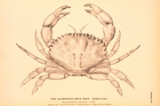
Cancer antennarius
Encyclopedia
Romaleon antennarium, commonly known as the Pacific or California rock crab, is a crab
of the genus Romaleon
(formerly Cancer
) found on the western coast of North America
.
with eleven teeth to either side of the eyestalks, the widest point falling at the eighth or ninth tooth. The chelipeds are quite stout with the black tips bent downward. The antennae are long and prominent, accounting for the specific name. The dorsal surfaces of adults are uniformly red, but the ventral surface of the carapace is spotted.
This species is easily confused with the red rock crab, Cancer productus
. They can be distinguished by the less prominent antennae, less robust claws, and lack of ventral spots on the latter.
Crab
True crabs are decapod crustaceans of the infraorder Brachyura, which typically have a very short projecting "tail" , or where the reduced abdomen is entirely hidden under the thorax...
of the genus Romaleon
Romaleon
Romaleon is a genus of marine crabs formerly considered in the genus Cancer.-Species:The genus, as currently circumscribed, contains seven species:*Romaleon antennarium Stimpson, 1856*Romaleon branneri Rathbun, 1926...
(formerly Cancer
Cancer (genus)
Cancer is a genus of marine crabs in the family Cancridae. It includes 8 extant species and 3 extinct species, including familiar crabs of the littoral zone, such as the European edible crab , the Jonah crab and the red rock crab...
) found on the western coast of North America
North America
North America is a continent wholly within the Northern Hemisphere and almost wholly within the Western Hemisphere. It is also considered a northern subcontinent of the Americas...
.
Description
Romaleon antennarium has a fan-shaped carapaceCarapace
A carapace is a dorsal section of the exoskeleton or shell in a number of animal groups, including arthropods such as crustaceans and arachnids, as well as vertebrates such as turtles and tortoises. In turtles and tortoises, the underside is called the plastron.-Crustaceans:In crustaceans, the...
with eleven teeth to either side of the eyestalks, the widest point falling at the eighth or ninth tooth. The chelipeds are quite stout with the black tips bent downward. The antennae are long and prominent, accounting for the specific name. The dorsal surfaces of adults are uniformly red, but the ventral surface of the carapace is spotted.
This species is easily confused with the red rock crab, Cancer productus
Cancer productus
Cancer productus, one of several species known as the red rock crab, is a crab of the genus Cancer found on the western coast of North America.- Description :...
. They can be distinguished by the less prominent antennae, less robust claws, and lack of ventral spots on the latter.

